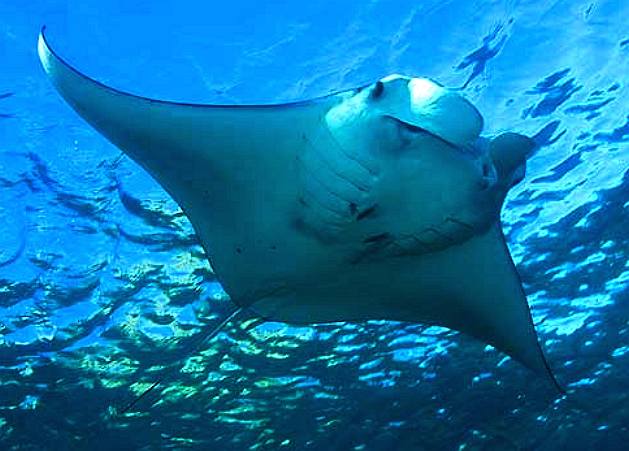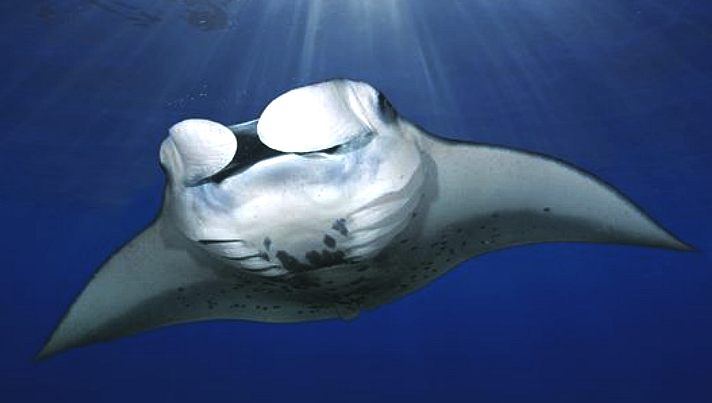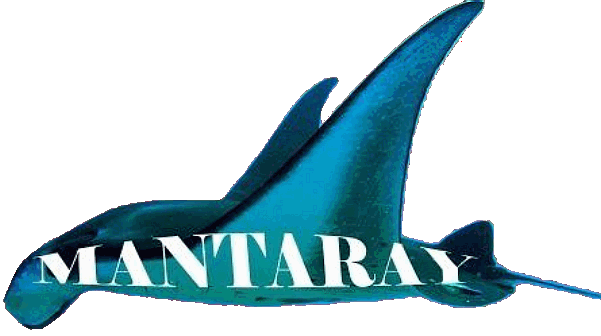|

Manta rays are large eagle rays belonging to the genus Manta. The larger species, M. birostris, reaches 7 m (23 ft) in width while the smaller, M. alfredi, reaches 5.5 m (18 ft). Both have triangular pectoral fins, horn-shaped cephalic fins and large, forward-facing mouths. They are classified among the Elasmobranchii (sharks and rays) and are placed in the eagle ray family Myliobatidae.
Mantas can be found in temperate, subtropical and tropical waters. Both species are pelagic; M. birostris migrates across open oceans, singly or in groups, while M. alfredi tends to be resident and coastal. They are filter feeders and eat large quantities of zooplankton, which they swallow with their open mouths as they swim. Gestation lasts over a year, producing live pups. Mantas may visit cleaning stations for the removal of parasites. Like whales, they breach, for unknown reasons.
Both species are listed as Vulnerable by the International Union for Conservation of Nature. Anthropogenic threats include pollution, entanglement in fishing nets, and direct harvesting for their gill rakers for use in Chinese medicine. Their slow reproductive rate exacerbates these threats. They are protected in international waters by the Convention on Migratory Species of Wild Animals, but are more vulnerable closer to shore. Areas where mantas congregate are popular with tourists. Only a few aquariums are large enough to house them. In general, these large fish are seldom seen and difficult to study.
BIOLOGY
Manta rays are known for their large size, broad heads, triangular pectoral fins, and the horn-shaped cephalic fins located on either side of their mouths. They have horizontally flattened bodies with eyes on the sides of their heads (behind the cephalic fins) and gill slits on their ventral surfaces. Their tails lack skeletal support and are shorter than their disc-like bodies. The dorsal fins are small and at the base of the tail. The largest mantas can reach 1,350 kg (3,000 lb). In both species the width is approximately 2.2 times the length of the body; M. birostris reaches at least 7 m (23 ft) in width while M. alfredi reaches about 5.5 m (18 ft). Dorsally, mantas are typically black or dark in color with pale markings on their "shoulders". Ventrally, they are usually white or pale with distinctive dark markings by which individual mantas can be recognized. All black color morphs are known to exist. The skin is covered in mucus which protects it from infection.
The two species of manta differ in color patterns, dermal denticles, and dentition. M. birostris has more angular shoulder markings, larger ventral dark spots on the abdominal region, charcoal-colored ventral outlines on the pectoral fins and a dark colored mouth. The shoulder markings of M. alfredi are more rounded, while its ventral spots are located near the posterior end and between the gill slits, and the mouth is white or pale colored. The denticles have multiple cusps and overlap in M. birostris, while those of M. alfredi are evenly spaced and lack cusps. Both species have small square shaped teeth on the lower jaw but M. birostris also has enlarged teeth on the upper jaw. In addition, unlike M. alfredi, M. birostris has a caudal spine near its dorsal fin.
Mantas move through the water by the wing-like movements of their pectoral fins, which drive water backwards. Their large mouths are rectangular, and face forward as opposed to other ray and skate species with downward-facing mouths. The spiracles typical of Chondrichthyes are vestigial, and mantas must swim continuously to keep oxygenated water passing over their gills.:2–3 The cephalic fins are usually spiralled, but flatten during foraging. The fish's gill arches have pallets of pinkish-brown spongy tissue that collect food particles. Mantas track down prey with visual and olfactory senses. They have one of the highest brain-to-body mass ratios of all fish, and their rete mirabiles may serve to keep their brains warm.
HABITAT
Mantas are found in tropical and sub-tropical waters in all the world's major oceans and also venture into temperate seas. The furthest from the equator they have been recorded is South Carolina in the United States (31ºN) to the north, and the North Island of New Zealand (36ºS) to the south. They prefer water temperatures above 68 °F (20 °C) and M. alfredi is predominantly found in tropical areas. Both species are pelagic. M. birostris lives mostly in the open ocean, traveling with the currents and migrating to areas where upwellings of nutrient-rich water increase prey concentrations. Fish that have been fitted with radio transmitters have traveled as far as 1,000 km (620 mi) from where they were caught and descended to depths of at least 1,000 metres (3,300 ft). M. alfredi is a more resident and coastal species. Seasonal migrations do occur but they are shorter than those of M. birostris. Mantas are common around coasts from spring to fall but travel further offshore during the winter. They keep close to the surface and in shallow water in daytime, while at night they swim at greater depths.

CONSERVATION
The greatest threat to manta rays is overfishing. M. birostris is not evenly distributed over the oceans but is concentrated in areas that provide the food resources it requires, while M. alfredi is even more localized. Their distributions are thus fragmented, and there is little evidence of intermingling of sub-populations. Because of their long lifespan and low reproductive rate, overfishing can severely reduce local populations with little likelihood that individuals from elsewhere will replace them.
Both commercial and artisanal fisheries have targeted mantas for their meat and products. They are typically caught with nets, trawls and harpoons. Mantas were historically captured by fisheries in California and Australia for their liver oil and skin; the latter were used as abrasives. The flesh is edible and is consumed in some countries, but is "grainy" and unattractive compared to other fish. Demand for their gill rakers, the cartilaginous structures protecting the gills, has recently entered Chinese medicine. To fill the growing demand in Asia for gill rakers, targeted fisheries have developed in Philippines, Indonesia, Mozambique, Madagascar, India, Pakistan, Sri Lanka, Brazil and
Tanzania. Each year, thousands of manta rays, primarily M. birostris, are caught and killed purely for their gill rakers. A fisheries study in Sri Lanka and India estimated that over a thousand were being sold in the country's fish markets each year. By comparison, M. birostris populations at most of the key aggregation sites around the world are estimated to have significantly fewer than one thousand individuals. Targeted fisheries for manta rays in the Gulf of California, the west coast of Mexico, India, Sri Lanka, Indonesia, and the Philippines have reduced populations in these areas dramatically.
Manta rays are subject to other anthropogenic threats. Because mantas must swim constantly to flush oxygen-rich water over their gills, they are vulnerable to entanglement and subsequent suffocation. Mantas cannot swim backwards and, because of their protruding cephalic fins, are prone to entangling in fishing lines, nets and even loose mooring lines. When snared, mantas often attempt to free themselves by somersaulting, tangling themselves further. It is possible for a loose, trailing line to wrap round and cut its way into its flesh, resulting in irreversible injury. Similarly, mantas become entangled in gill nets designed for smaller fish. Some mantas are injured by collision with boats, especially in areas where they congregate and are easily observed. Other threats or factors that may impact on manta numbers are climate change, tourism, pollution from oil spills, and the ingestion of microplastics.

STATUS
In 2011, mantas became strictly protected in international waters thanks to their inclusion in the Convention on Migratory Species of Wild Animals. The CMS is an international treaty organization concerned with conserving migratory species and habitats on a global scale. Although individual nations were already protecting manta rays, the fish often migrate through unregulated waters, putting them at increased risk from overfishing. The International Union for Conservation of Nature (IUCN) declared M. birostris to be 'Vulnerable with an elevated risk of extinction' in November 2011'. In the same year, M. alfredi was also classified as 'Vulnerable' with local populations of fewer than a thousand individuals and little or no interchange between subpopulations. The Manta Trust is a UK-based charity dedicated to research and conservation efforts for manta rays. The organization's website is also an information resource for manta conservation and biology.
Besides these international initiatives, some countries are taking their own actions. New Zealand has banned the taking of manta rays since the introduction of the Wildlife Act in 1953. In June 1995, the Maldives banned the export of all ray species and their body parts, effectively putting a stop to manta fishing as there had not previously been a fishery for local consumption. The government reinforced this in 2009 by the introduction of two marine protected areas. In the Philippines, the taking of mantas was banned in 1998, but this was overturned in 1999 under pressure from local fishermen. Fish stocks were surveyed in 2002, and the ban was reintroduced. The taking or killing of mantas in Mexican waters was prohibited in 2007. This ban may not be strictly enforced but laws are being more rigidly applied at Isla Holbox, an island off the Yucatán Peninsula, where the manta ray is used to attract tourists. In 2009, Hawaii became the first state in the United States to introduce a ban on the killing or capturing of manta rays. Previously, there was no fishery for mantas in the state, but migratory fish that pass the islands are now protected. In 2010, Ecuador introduced a law prohibiting all fishing for manta and other rays, their retention as bycatch, and their sale.
SIGHTSEEING
Sites at which manta rays congregate attract tourists, and manta viewing generates substantial annual revenue for local communities. Tourist sites exist in the Bahamas, the Cayman Islands, Spain, the Fiji Islands, Thailand, Indonesia, Hawaii, Western Australia and the Maldives. Mantas are popular because of their enormous size and because they are easily habituated to humans. Scuba divers may get a chance to watch mantas visiting cleaning stations and night dives enable viewers to see mantas feeding on plankton attracted by the lights.
Ray tourism benefits locals and visitors by raising awareness of natural resource management and educating them about the animals. It can also provide funds for research and conservation. However, constant unregulated interactions with tourists can negatively affect the fish by disrupting ecological relationships and increasing disease transmission. At Bora Bora, an excessive number of swimmers, boaters and
jet skiers caused the local manta ray population to abandon the area.
POPULAR FISH:
Please
use the Index below to navigate the Animal Kingdom:-
|
AMPHIBIANS |
Such
as frogs (class: Amphibia) |
|
ANNELIDS |
As
in Earthworms (phyla: Annelida) |
|
ANTHROPOLOGY |
Neanderthals,
Homo Erectus (Extinct) |
|
ARACHNIDS |
Spiders
(class: Arachnida) |
|
BIRDS
|
Such
as Eagles, Albatross
(class: Aves) |
|
CETACEANS
|
such
as Whales
& Dolphins
( order:Cetacea) |
|
CRUSTACEANS |
such
as crabs (subphyla: Crustacea) |
|
DINOSAURS
|
Tyranosaurus
Rex,
Brontosaurus (Extinct) |
|
ECHINODERMS |
As
in Starfish (phyla: Echinodermata) |
|
FISH
|
Sharks,
Tuna (group: Pisces) |
|
HUMANS
-
MAN |
Homo
Sapiens THE
BRAIN |
|
INSECTS |
Ants,
(subphyla: Uniramia class: Insecta) |
|
LIFE
ON EARTH
|
Which
includes PLANTS
non- animal life |
|
MAMMALS
|
Warm
blooded animals (class: Mammalia) |
|
MARSUPIALS |
Such
as Kangaroos
(order: Marsupialia) |
|
MOLLUSKS |
Such
as octopus (phyla: Mollusca) |
|
PLANTS |
Trees
- |
|
PRIMATES |
Gorillas,
Chimpanzees
(order: Primates) |
|
REPTILES |
As
in Crocodiles,
Snakes (class: Reptilia) |
|
RODENTS |
such
as Rats, Mice (order: Rodentia) |
|
SIMPLE
LIFE FORMS
|
As
in Amoeba, plankton (phyla: protozoa) |
|
|
LINKS
Wikipedia
Piranha
Wikipedia
Flying_fish
Wikipedia
Barracuda
Wikipedia
Manta_ray
Wikipedia
Bluefish
Wikipedia
Tuna
http://en.wikipedia.org/wiki/Piranha
http://en.wikipedia.org/wiki/Flying_fish
http://en.wikipedia.org/wiki/Barracuda
https://en.wikipedia.org/wiki/Manta_ray
http://en.wikipedia.org/wiki/Bluefish
http://en.wikipedia.org/wiki/Tuna
ACIDIFICATION
- ADRIATIC
- ARCTIC
- ATLANTIC
- BALTIC
- BERING
- CARIBBEAN
- CORAL
- EAST
CHINA
ENGLISH
CH - GOC
- GULF
MEXICO - INDIAN
- MEDITERRANEAN
- NORTH
SEA - PACIFIC
- PERSIAN
GULF - SEA
JAPAN
STH
CHINA - PLASTIC
- PLANKTON
- PLASTIC
OCEANS - SEA
LEVEL RISE - UNEP
- WWF

|



